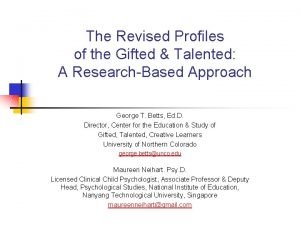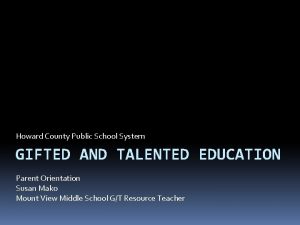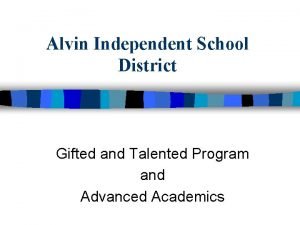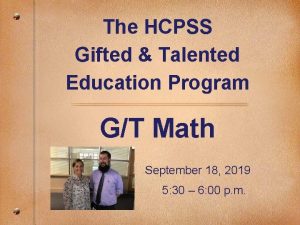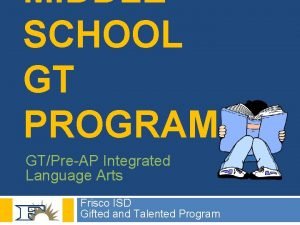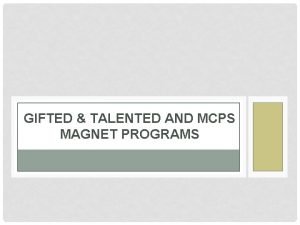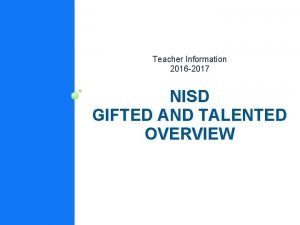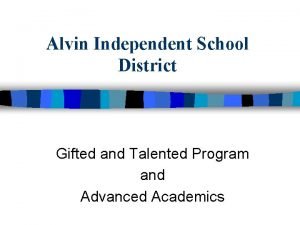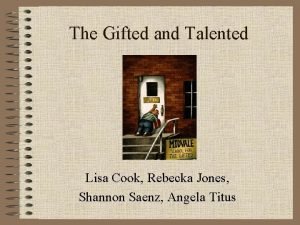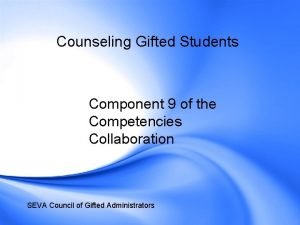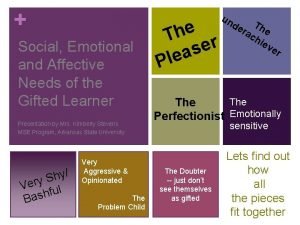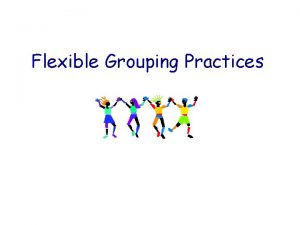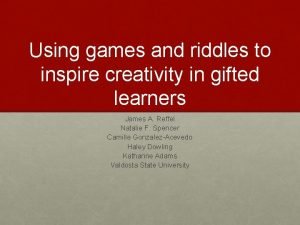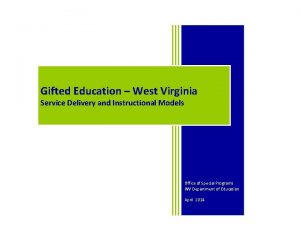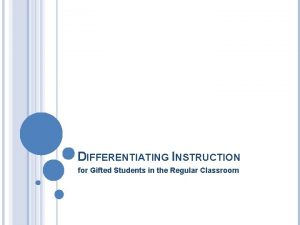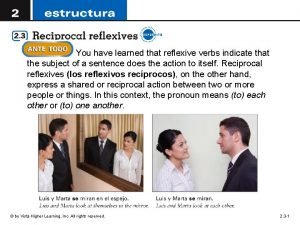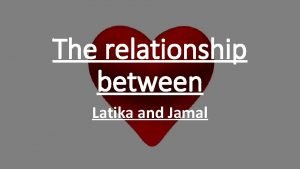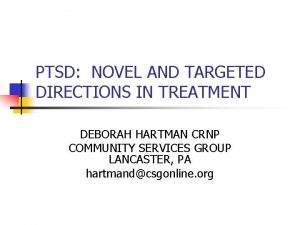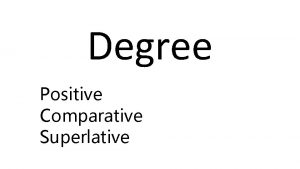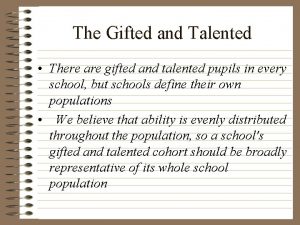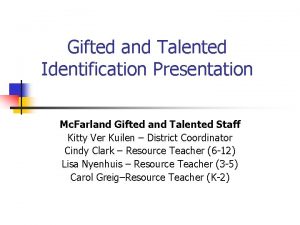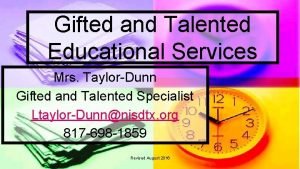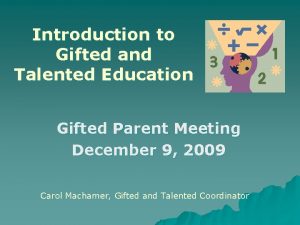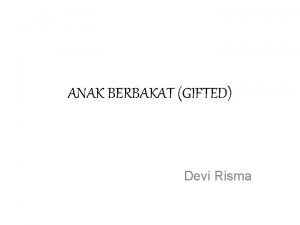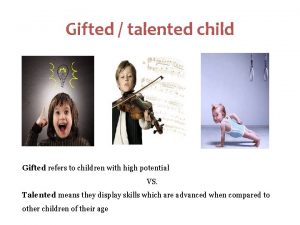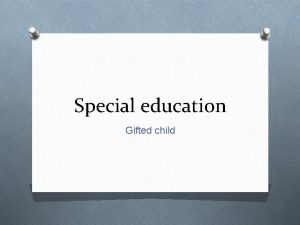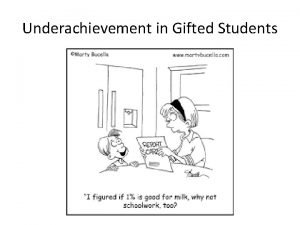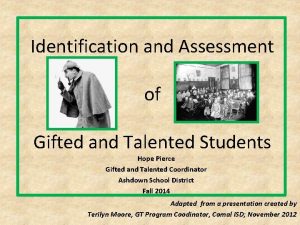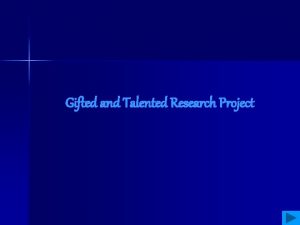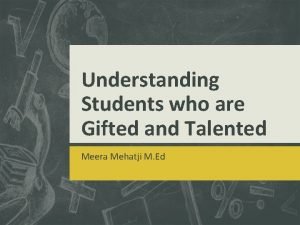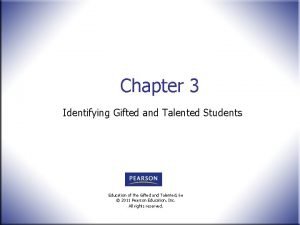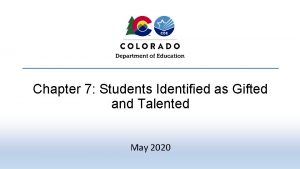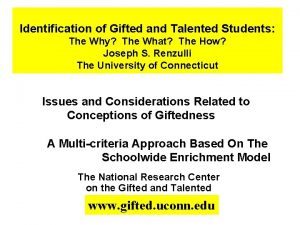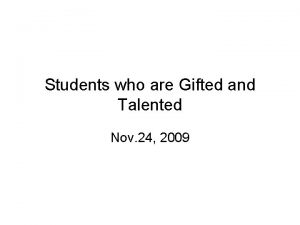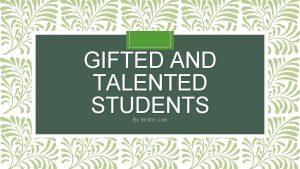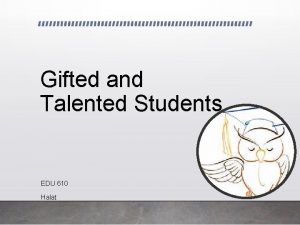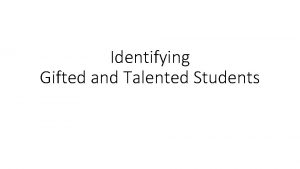Gifted and Talented Students Sarah Jamal Laura Karaleviciute























- Slides: 23

Gifted and Talented Students Sarah Jamal, Laura Karaleviciute and Hafsa Jamalvi

Definition Gifted students include those who are identified as having outstanding abilities, being capable of high performance and those who have demonstrated high achievement.

Gifted Behavior ● Above Average Ability(High abstract thinking, ability to sort out relevant from irrelevant information and ability to use advanced strategies while solving a problem. ) ● Task Committed(High levels of interest and enthusiasm, high standards, determination). ● Creativity(Curiosity, risk taking, open to new ideas, originality. )

Assessing Each giftedness category has to be assessed in various ways using both informal and formal measures. Informal: Ex-Jot Down(teachers observe characteristics and behaviors of students and jot down the name of the student that is being observed. ) Formal: Ex-Off Level Testing(using a test for older students such as the Woodcock-Johnson III Test of Achievement to measure a specific area of reading or math. Using SAT with middle school students to measure achievement in math or verbal ability. )

Example of a Jot-Down Sheet

Assessment Continued. . . Creativity -teachers often assess creativity through creative products or tests of creative thinking. -use rubrics, etc… -test created by E. Paul Torrence(1966, 1998) and Frank Williams(1993) are frequently used to assess creative thinking skills. DAP-Developing and Assessing Products Tool -more recent assessment instrument using creativity as one of the 4 components when evaluating student work products.

Sample Problems



History Gifted and talented education in the United States started in the late nineteenth century but grew and developed in the twentieth century. ● development of intelligence testing led to the study of gifted individuals ● Measuring intelligence was done by Alfred Binet ● Lewis Terman is known as the founder of gifted education ● William Stern, a psychologist, developed the formula for the intelligence quotient (IQ)

History Continued. . . ● Leta Hollingworth wrote the first comprehensive textbook on gifted education, believed that giftedness is influenced by both heredity and environment. ● J. P. Guilford published a book in which he described multiple intelligences; total of 120 different kinds of intelligences ● The National Association for Gifted Children (NAGC) started in 1954 and the Association for the Gifted (1958) ● Virgil Ward and differential education

Continued. . . ● Howard Gardner and Robert Sternberg and their theories of multiple intelligences. ● A Nation at Risk described the state of education in U. S. schools as terrible. ● The Jacob K. Javits Gifted and Talented Students Education Act was passed in 1988 ● The National Association for Gifted Children (2010) issued the Pre-K-Grade 12 Gifted Programming Standards

Prevalence ● “Educators believe that approximately 3 to 5 percent of the school-age population is gifted. ” ● The National Association for Gifted Children (2013) estimates that approximately 3 million children are gifted and talented.

Etiology ● Giftedness results from a combination of genetic makeup and environmental stimulation ● The brain changes physically and chemically when stimulated or challenged. ● Parents and educators play an important role in developing a child’s capacity ot learn at high levels

Characteristics - perform tasks on an advanced schedule display exceptional memories and learn at a rapid pace knowledgeable about things which their peers are not aware of interested in learning at a challenging pace - single minded ( ability to develop interest /talent to an exceptional level exceptionally creative leadership quality decision making can become bossy charismatic qualities display exceptional talent in visual / performing arts

Educational Considerations - differentiation of curriculum is important to accommodate and provide a learning environment appropriate for talented students needs - curriculum compacting - strategy that responds well to the characteristics of children who are gifted and talented intellectually in specific areas - cluster grouping - placing 5 or more students with similar needs and abilities with one teacher to promote challenging development - tiered assignments - instructional strategy that allows the teacher to offer variation of the same lesson to students with differing level of ability

Educational Considerations (Cont. ) Creativity - gifted students should be given the opportunity to develop talent in a risk free environment where they can interact with creative possibilities. ● most classroom settings are restrictive for gifted students ● goal : develop each pupil's talent to the fullest degree ● talented students need ongoing instructions - acceleration : instructional strategy typically used with pupils who are gifted and talented; one approach is placing students in a grade level beyond their chronological age - acceleration includes skipping grades, starting school at younger age, accelerated reading, advanced courses, college board placement classes in highschool and early entrance into college.

Transitioning to Adulthood - Early adolescent is a challenging time where students all over are trying to fit in - gifted middle schoolers need challenging opportunities to make continuous progress in their talented areas] - Magnet high school: school with strong instructional emphasis on a particular theme, such as performing arts, math and science. This is one of the options for gifted students. - Mena: social international organization consisting of individuals who have an IQ in the top 2% percent of the general population.

Trends, Issues and Controversies The United States is facing a “quiet crisis” in how we educate our top students. -Students are not challenged enough to work to their full potential. -Teachers need to be qualified and experienced! -Makes if difficult to compete in a global economy. -Goals 2000: Educate America Act predicted that students in the US would be the first in the world in mathematics and science by 2000. Unfortunately, we will have this issue. -Students who score at the 95 th percentile in US are at the 50 th percentile in Japan!!!(Not challenged enough. ) - More rigorous curriculums are needed! -Differentiated instruction is necessary to meet the needs of now only low achieving students, but high achieving students as well! -Teachers need to know their students, their strengths, areas that need improvement, their hobbies, family information and their educational backgrounds. -Modifications needed for one gifted student might vary from modifications needed for another student.

Continued. . -National Research Center on the Gifted and Talented indicate that 3 rd and 4 th grade teachers typically make only minor modifications in the regular curriculum to address the needs of gifted students. What teachers can do: ● Provide students with menus for different projects and/or assignments. ● Design assignments/projects/etc around students interest. ● Provide students with opportunities to practice skills. ● Monitor student progress. ● Allow students to work with other gifted students. -Many teachers believe that students who are gifted don’t need as much assistance and attention as average or below average students. ● Students need qualified teachers and mentors that will work with them in their talent areas, expand their knowledge and refine their skills. -Schools need to celebrate artistic and academic talents the same way they do athletic talents. Students need to be recognized and accepted by their schools!

Video https: //www. youtube. com/watch? v=GKA_c. Kct 9 h 0

High Achiever, Gifted Learner and Creative Thinker Something to think about. . . High Achiever Gifted Learner Creative Thinker Performs at the top of the group Is beyond the group Is in own group Learns with ease Already knows Questions: What if. . . Is accurate and complete Is original and continually developing Is original, ever changing, and misunderstood Is interested Is curious Wonders Get’s A’s May not be motivated by grades

References ● Gargiulo, R. M. (2015). Special education in contemporary society (5 th ed. ). SAGE. ● Kingore, B. (2004). Differentiation: simplified, realistic, and effective. Austin: Professional Associates Publishing. ● Political and academic issues facing gifted students [Video file]. (2014, June 3). Retrieved from https: //www. youtube. com/watch? v=GKA_c. Kct 9 h 0
 Profiles of the gifted and talented
Profiles of the gifted and talented A government program for gifted students in the philippines
A government program for gifted students in the philippines Howard county gifted and talented
Howard county gifted and talented Alvin isd gifted and talented
Alvin isd gifted and talented Hcpss gifted and talented
Hcpss gifted and talented Frisco isd gt program
Frisco isd gt program Howard county gifted and talented
Howard county gifted and talented Mcps magnet program
Mcps magnet program The anderson school gifted and talented nyc
The anderson school gifted and talented nyc Nisd gifted and talented program
Nisd gifted and talented program Alvin isd gifted and talented
Alvin isd gifted and talented Gifted vs talented
Gifted vs talented Counseling strategies for gifted students
Counseling strategies for gifted students Affective needs of gifted students
Affective needs of gifted students Define flexible grouping
Define flexible grouping Riddles for gifted students
Riddles for gifted students Intellectually gifted
Intellectually gifted Gifted choice boards
Gifted choice boards Describe a laura y a elián usando los verbos recíprocos.
Describe a laura y a elián usando los verbos recíprocos. Jamal latika
Jamal latika Jamal and deborah therapy
Jamal and deborah therapy Superlative degree talented
Superlative degree talented Creer emploi du temps
Creer emploi du temps Marian congregation rizal
Marian congregation rizal
